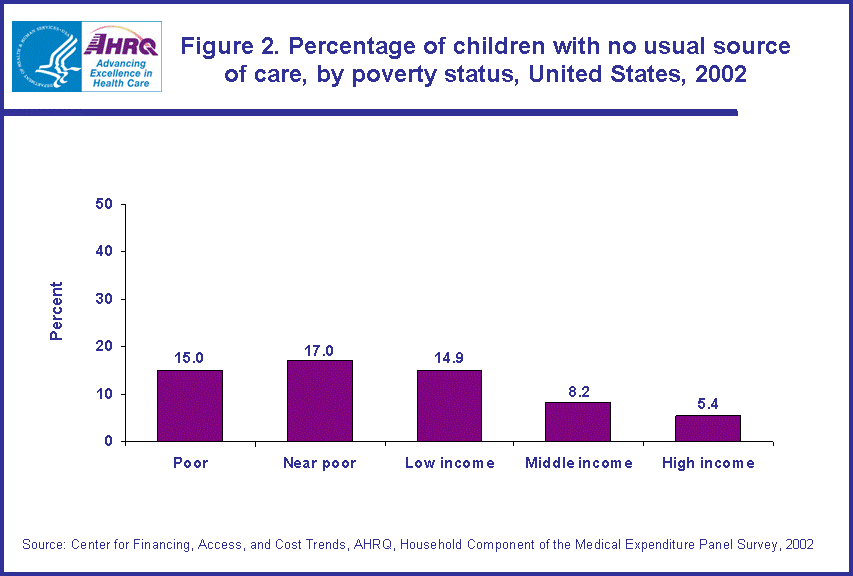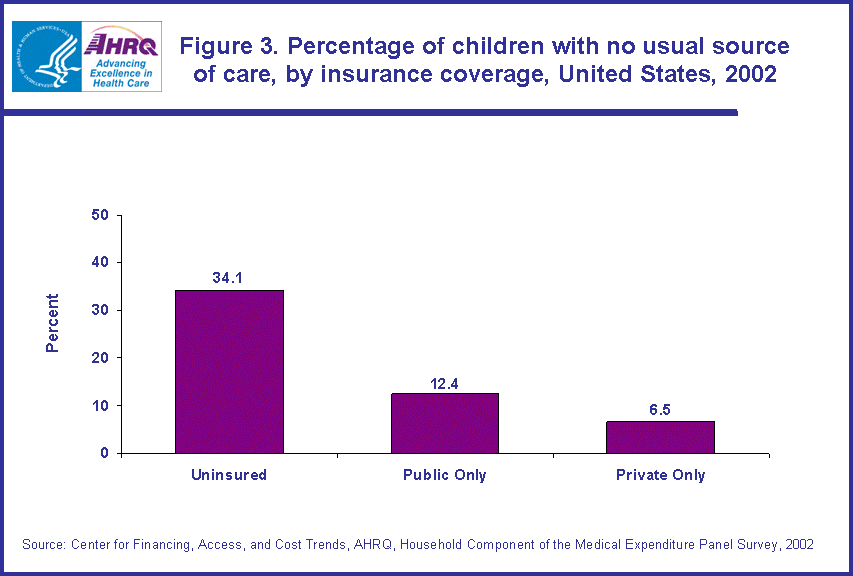
|
|
Font Size:
|
||||
|
|
|
|
||||
STATISTICAL BRIEF #78:
Children's Usual Source of Care: United States, 2002
Highlights
- More than 7 million American children under 18 were reported to have no usual place to go for health care during 2002.
- Children who were uninsured were more likely to lack a usual source of care than children with public only insurance. Similarly, children with public only insurance were more likely to lack a usual source of care than those with private only insurance.
- Hispanic children were more likely to lack a usual source of medical care than children who were white, black, or other/multiple race.
- In 2002, lower income children were more likely than middle and high income children to lack a usual source of health care.
Introduction
One goal of a health care system is to provide effective, equitable, and cost-effective health services to the population. A measure of a health care system's effectiveness is the degree to which the population served can identify a place where they can receive routine medical care. Previous findings have shown that not having a usual source of care is linked with race/ethnicity, health insurance status, and family income. This may be especially true for populations such as uninsured children. Uninsured children are less likely to have their medical care needs met. In addition, uninsured children are much less likely to get immunizations, medicine, and treatment for ordinary childhood conditions, such as sore throats, ear infections, and asthma, which have severe consequences if left untreated.*
This Statistical Brief provides estimates of the proportion of children under 18 who lacked a usual source of care in 2002, by race/ ethnicity, age, income, and insurance coverage. Only differences that are statistically significant at the 0.05 level are discussed in the text.
Findings
In 2002, approximately 10.1 percent of the 72.7 million U.S. population of children younger than 18 was reported as having no usual source of care. This translates into about 7.3 million children not having a usual place to go for health care.
White children (7.3 percent) were less likely than any other race/ethnic group to lack a usual source of care. Hispanic children (18.1 percent) were more likely than children of any other race/ethnic group to lack a usual source of care. Likewise, other/multiple race children (12.3 percent) and black children (10.6 percent) were more likely than white children (7.3 percent) to lack a usual source of care. (figure 1)
With respect to family income, lower income children were less likely than middle and high income children to have a usual source of medical care. While only 5.4 percent of high income and 8.2 percent of middle income children did not have a usual source of care, 14.9 percent of low income, 17.0 percent of near poor, and 15.0 percent of poor children did not have a usual source of care. (figure 2)
Uninsured children were more than five times (34.1 percent) as likely to lack a usual source of care as children with private only insurance (6.5 percent). Likewise, children who were uninsured were nearly three times as likely to lack a usual source of care as those with public only insurance (12.4 percent). (figure 3)
Data Source
The estimates in this Statistical Brief are based on data from the Household Component of the Medical Panel Expenditure Survey (MEPS-HC) for 2002. The usual source of care questions are contained in the Access to Care section of the survey. One household respondent reported information for all members of the household.
Definitions
Health insurance status
Respondents were asked about health insurance coverage for themselves and all household members at each round of interviewing. Persons were classified according to whether they had private health insurance only, public coverage only, or were uninsured all year.
- Private only: Persons having insurance at any time during the year that provided coverage for hospital and physician care from a nonpublic source. Coverage only by private single-service plan (e.g., coverage for dental or vision care only or coverage for accidents or specific diseases) was not defined as private health insurance.
- Public only: Persons who were never covered by private insurance during the year but who were covered at any time by Medicaid, State and local medical assistance programs, and TRICARE (which covers retired members of the uniformed services and the spouses and children of active-duty military).
- Uninsured: Persons with neither public nor private insurance coverage throughout the calendar year.
This refers to a particular doctor's office, clinic, health center, or other place where a person usually goes if he or she is sick or needs advice about personal health matters.
Race/ethnicity
This is coded hierarchically into the following codes: White single race, black single race, Hispanic or Latino, and other/multiple race.
Poverty status
Income is expressed in terms of poverty status, the ratio of the family's income to the Federal poverty thresholds, which control for the size of the family and the age of the head of the family (see the 2002 U.S. Department of Health and Human Services Poverty Guidelines at http://aspe.hhs.gov/poverty/02poverty.htm for more details). In this Statistical Brief, the following classifications were used:
- Poor: Persons in families at or below the poverty line.
- Near poor: Persons in families over the poverty line through 125 percent of the poverty line.
- Low income: Persons in families with income from 125 percent to less than 200 percent of the poverty line.
- Middle income: Persons in families with income from 200 percent to less than 400 percent of the poverty line.
- High income: Persons in families with income at or over 400 percent of the poverty line.
About MEPS-HC
MEPS-HC is a nationally representative longitudinal survey that collects detailed information on health care utilization and expenditures, health insurance, and health status, as well as a wide variety of social, demographic, and economic characteristics for the civilian noninstitutionalized population. It is cosponsored by the Agency for Healthcare Research and Quality and the National Center for Health Statistics.
For more information about MEPS, call the MEPS information coordinator at AHRQ (301-427-1656) or visit the MEPS Web site at http://www.meps.ahrq.gov/.
References
For a detailed description of the MEPS-HC survey design, sample design, and methods used to minimize sources on nonsampling error, see the following publications:
Cohen, J. Design and Methods of the Medical Expenditure Panel Survey Household Component. MEPS Methodology Report No. 1. AHCPR Pub. No. 97-0026. Rockville, Md.: Agency for Health Care Policy and Research, 1997.
Cohen, S. Sample Design of the 1996 Medical Expenditure Panel Survey Household Component. MEPS Methodology Report No. 2. AHCPR Pub. No. 97-0027. Rockville, Md.: Agency for Health Care Policy and Research, 1997.
Cohen, S. Design Strategies and Innovations in the Medical Expenditure Panel Survey. Medical Care, July 2003: 41(7) Supplement: III-5-III-12.
Suggested Citation
Brown, E., Jr. Children's Usual Source of Care: United States, 2002. Statistical Brief #78. May 2005. Agency for Healthcare Research and Quality, Rockville, Md. http://meps.ahrq.gov/mepsweb/data_files/publications/st78/stat78.shtml
Footnote
* Children's Health--Why Health Insurance Matters, Fact Sheet (#4055), May 2002. Kaiser Commission on Medicaid and the Uninsured, Kaiser Family Foundation, Washington, D.C.
 |
||||||||||||||||||||||||
|
||||||||||||||||||||||||
|
|
||||||||||||||||||||||||
 |
||||||||||||||||||||||||
|
||||||||||||||||||||||||
|
|
||||||||||||||||||||||||
 |
||||||||||||||||||||||||
|
||||||||||||||||||||||||
|
|
||||||||||||||||||||||||


